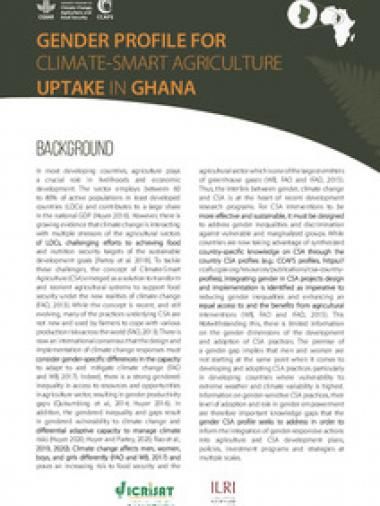Gender profile of climate-smart agriculture in Ghana

In most developing countries, agriculture plays a crucial role in livelihoods and economic development.
The sector employs between 60 to 80% of active populations in least developed countries (LDCs) and
contributes to a large share in the national GDP (Huyer 2016). However, there is growing evidence that
climate change is interacting with multiple stressors of the agricultural sectors of LDCs, challenging
efforts to achieving food and nutrition security targets of the sustainable development goals [Partey et al.
2018]. To tackle these challenges, the concept of Climate-Smart Agriculture (CSA) emerged as a solution
to transform and reorient agricultural systems to support food security under the new realities of climate
change (FAO, 2013). While the concept is recent, and still evolving, many of the practices underlying
CSA are not new and used by farmers to cope with various production risks across the world (FAO,
2013). There is now an international consensus that the design and implementation of climate change
responses must consider gender-specific differences in the capacity to adapt to and mitigate climate
change (FAO and WB, 2017). Indeed, there is a strong gendered inequality in access to resources and
opportunities in agriculture sector, resulting in gender productivity gaps (Quisumbing et al., 2014; Huyer
2016). In addition, the gendered inequality and gaps result in gendered vulnerability to climate change
and differential adaptive capacity to manage climate risks (Huyer 2020; Huyer and Partey, 2020; Rao et
al., 2019, 2020). Climate change affects men, women, boys, and girls differently (FAO and WB, 2017)
and poses an increasing risk to food security and the agriculturalsector which is one of the largest emitters
of greenhouse gases (WB, FAO and IFAD, 2015). Thus, the interlink between gender, climate change
and CSA is at the heart of recent development research programs. For CSA interventions to be more
effective and sustainable, it must be designed to address gender inequalities and discrimination against
vulnerable and marginalized groups. While countries are now taking advantage of synthesized countryspecific knowledge on CSA through the country CSA profiles (e.g.: CCAFS profiles,
https://ccafs.cgiar.org/resources/publications/csa-country-profiles), integrating gender in CSA projects
design and implementation is identified as imperative to reducing gender inequalities and enhancing an
equal access to and the benefits from agricultural interventions (WB, FAO and IFAD, 2015). This
Notwithstanding this, there is limited information on the gender dimensions of the development and
adoption of CSA practices. The premise of a gender gap implies that men and women are not starting at
the same point when it comes to developing and adopting CSA practices particularly in developing
countries where vulnerability to extreme weather and climate variability is highest. Information on
gender-sensitive CSA practices, their level of adoption and role in gender empowerment are therefore important knowledge gaps that the gender CSA profile seeks to address in order to inform the integration
of gender-responsive actions into agriculture and CSA development plans, policies, investment programs
and strategies at multiple scales
Citation
CCAFS. 2021. Gender profile of climate-smart agriculture in Ghana. CGIAR Research Program on Climate Change, Agriculture and Food Security (CCAFS), West Africa Program, International Crops Research Institute for the Semi-Arid Tropics (ICRISAT).